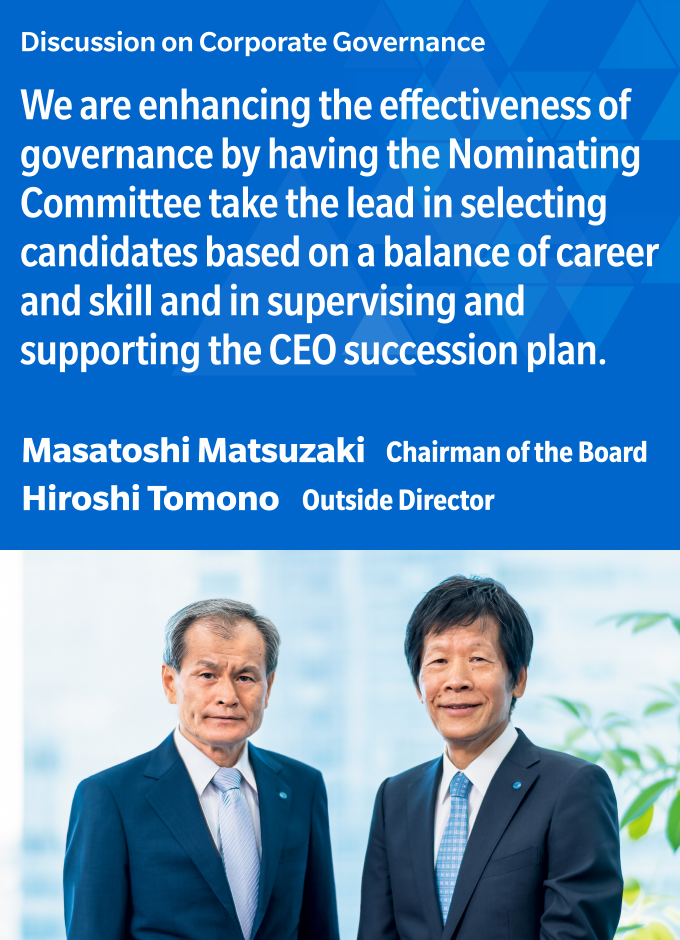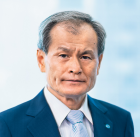
Chairman of the Board Masatoshi Matsuzaki
Profile After serving as a Director at Konica Minolta Business Technologies, Inc., as President of Konica Minolta Technology Center, Inc., and in various other roles, Matsuzaki became the President and CEO of Konica Minolta, Inc. He now serves as Chairman of the Board, a position he has held since April 2014.
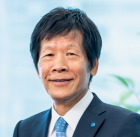
Outside Director Hiroshi Tomono
Profile After serving as President at Sumitomo Metal Industries, Ltd. and subsequently as Representative Director, President and COO, and Representative Director and Vice Chairman at Nippon Steel & Sumitomo Metal Corporation, among other positions, Tomono became an Outside Director at Konica Minolta, Inc. in June 2015. He was appointed Chairman of the Nominating Committee in June 2016.
Board composition and selection process for Director candidates
Can you describe Konica Minolta's selection process for Director candidates and criteria?
- Matsuzaki:
- Every year, the selection process for next year's Director candidates gets underway as soon as Directors are elected at the Ordinary Shareholders' Meeting. We begin by reviewing the current state of the Board of Directors, and then examine proposals for the number of total board members, Outside Directors, non-executive Inside Directors, as well as executive officers serving concurrently as Inside Directors. At the same time, we check the outgoing Outside Directors and Inside Directors as of the next Ordinary Shareholders' Meeting and consider new candidates to fill these positions.
On top of this, we examine and determine the type of people we should appoint as next year's candidates for Director under the direction of the Chairman of the Nominating Committee.
- Tomono:
- Generally speaking, when it comes to Japanese companies, the President wields a great deal of influence in the selection of Director candidates. Actually, I have heard many cases where the President's preferences for new Directors are simply approved by the company's nominating committee. In contrast, Konica Minolta entrusts the selection process up to the Nominating Committee, which examines and determines the board composition for the subsequent year and the type of candidates needed.
When selecting Outside Director candidates, we prepare a long list by having the Nominating Committee together with other Outside Directors and the President recommend candidates based on the finalized board composition and candidate requirements. This long list is discussed by the Nominating Committee, which determines a priority order. Following this order, Chairman Matsuzaki and I together visit the candidates to gauge their interest in becoming an Outside Director.
- Matsuzaki:
- Previously, I served as President for five years and during this time I recommended candidates every year, but there was just one case where the candidate I recommended was approved. In other words, Konica Minolta's selection process for Outside Director candidates focuses on the most qualified candidate, regardless of who makes the recommendation.
Two new Outside Directors were elected this fiscal year. What elements did you emphasize in their selection?
- Tomono:
- This time the selection of Outside Director candidates emphasized compatibility with our management strategy. Under the TRANSFORM 2016 Medium Term Business Plan, Konica Minolta made efforts to shift to a business model where we provide customers with solution-based services. Under the new SHINKA 2019 Medium Term Business Plan, we are working to create business opportunities in new domains such as bio-healthcare, IoT, and digital solutions, while strengthening the profitability of our core business. For this reason, the element we emphasized the most this time around was the selection of candidates who can provide appropriate insight and advice within discussions on these strategies.
- Matsuzaki:
- In the selection of Outside Directors, we are mindful of a balance between each candidate's background and field of expertise, and give priority to candidates with a wealth of experience and knowledge in fields where we lack depth or in domains that we need in the future. For example, as was the case with Mr. Tomono, selected for his global manufacturing experience and ability to share his views after visiting the front lines, Mr. Noumi, selected for his ability to provide views from an investor perspective, and Mr. Hatchoji, selected for his experience in corporate governance at a global corporation, we ask people with their own unique field of expertise to serve as Outside Director. With this composition as the premise, as Mr. Tomono noted earlier, we added Mr. Fujiwara for his familiarity with the bio-healthcare field and Mr. Hodo for his ability to delve into the fundamental essence of IoT and digital domains.
- Tomono:
- This year the two candidates newly elected as Outside Director also have a wealth of experience in M&A to complement their individual fields of expertise. I believe this year we have a very powerful combination of board members when it comes to both balance of background, field of expertise and compatibility with strategy. In addition, three years have passed since I was elected as Outside Director; yet, I feel that the term of an Outside Director is but a short period of time when it comes to the long timeline of a company. This is why I feel Konica Minolta's selection of Outside Director candidates, which involves myself and Mr. Matsuzaki, who has been with the company even longer than I, is a very good system.
Two new Inside Directors were also elected this year. What elements did you emphasize in their selection?
- Tomono:
- This fiscal year the Nominating Committee emphasized the keywords "continuity" and "generational change." In terms of non-executive Inside Director, Mr. Matsuzaki and Mr. Shiomi were re-elected and Mr. Itoh was newly added. As for Executive Officer serving concurrently as Inside Director, Mr. Taiko was newly elected to go with Mr. Yamana, Mr. Hatano, and Mr. Koshizuka. In this manner, the main characteristic of this year's board is a generational change infusing new members while ensuring continuity with the re-election of current members.
- Matsuzaki:
- For Inside Directors, the President and I hold discussions and prepare a draft based on the elements emphasized by the Nominating Committee, as pointed out by Mr. Tomono. Following this, I propose candidates to the Nominating Committee. Non-executive Inside Directors serve as full-time Audit Committee members, and for this reason, I proposed candidates well versed in the group's internal control and business administration. Inside Directors who serve concurrently as Executive Officer need to fulfill additional accountability for the business they are responsible for at board meetings and other venues. For this reason, I proposed the officer for the mainstay Business Technologies Business.
This fiscal year Konica Minolta appointed its first female Executive Officer. What are your thoughts about female representation?
- Tomono:
- The fundamental principle in Konica Minolta's selection of Directors and Executive Officers is to choose candidates who can contribute to the company's sustained growth and enhance corporate value and candidates who can live up to stakeholder expectations. Such attributes as gender or nationality have no bearing under this fundamental principle.
- Matsuzaki:
- Recently there is widely growing awareness about the importance of diversity. For Konica Minolta, diversity has always been an integral part of our business operations. This selection of a female Executive Officer does not mean that we are simply following the latest trend.
- Tomono:
- For quite some time, women's names have appeared on the long list of Outside Director candidates and we have approached a number of women about the opportunity to serve as a Director. However, due to other obligations none of these individuals chose to become an official candidate for Director.
- Matsuzaki:
- Several years ago, the President asked me to select executive management, including women, and coach them as future candidates for Executive Officer. One of these candidates was the woman who was elected as Executive Officer this year. I believe that other talented and highly capable women will emerge from this type of development program.
CEO Succession Plan
What led to the Nominating Committee supervising the CEO succession plan?
- Matsuzaki:
- The impetus behind this decision was Japan's Corporate Governance Code introduced in 2015. I facilitated a roundtable discussion with the Board of Directors on the implementation of this code, where I listened to views with regard to the company's current status of compliance and the extent to which we should comply with the code in the future. As a result, we reached a consensus that included complying with the supplementary principle calling for the Board of Directors to supervise the CEO succession plan. As a company with three committees, Konica Minolta's Board of Directors fulfills its inherent roles and is placed in a position to supervise the execution of business, which is entrusted to the execution side whenever possible. One of these inherent roles is the selection of Executive Officers, and of particular importance the selection of the CEO. Given this, the CEO succession plan was fundamentally viewed as an action that should be supervised by the Board of Directors. Actually, we considered it realistic to make this a responsibility of the Nominating Committee, and currently we are implementing the supervision cycle through the Nominating Committee.
- Tomono:
- In the succession plan, the Board of Directors has the final say on the successor, and the Nominating Committee will check the development plan and provide advice from a supervisory position. Specifically, such requirements as the personal qualities, experience and career path deemed necessary of Konica Minolta's CEO not only reflect the current CEO's view, but also a consensus built while taking into account the views of Nominating Committee members.
- Matsuzaki:
- When considering the personal qualities deemed necessary of the CEO, for example, there are requirements common to any company, such as the ability to plan ahead, zeal for company growth, communications skills, and personal magnetism, as well as requirements unique to our company, such as specific experiences or familiarity with certain businesses. Our discussions have found that both are essential.
- Tomono:
- Based on these personal qualities and requirements, we prepare a long list of CEO candidates. The list includes a development plan that will pave the way for each candidate to become CEO in the future, including career path along with the experiences, knowledge and skills that need to be acquired. Furthermore, in the process of selecting and developing candidates, we assess candidate competency not only internally, but also using outside organizations. The results are shared with the Nominating Committee as well.
- Matsuzaki:
- In this manner, we monitor the development of successor candidates from various angles and narrow down the list of candidates.
- Tomono:
- As part of monitoring, we carefully check performance, such as their responses to questions by the Board of Directors. There are also many opportunities for me to visit the frontlines and attend research presentations. I find it very useful to evaluate a person based on their remarks and responses to questions during such occasions.
- Matsuzaki:
- As Mr. Tomono says, the best training is responses to questions and findings from Directors during board meetings. For that reason alone, there are times when such comments are deliberately severe.
What other efforts are the Board of Directors and Nominating Committee making with regard to developing the skills of Executive Officers outside of candidates for CEO successor?
- Matsuzaki:
- Over the past year the CEO's succession plan has gotten off the ground under the supervision of the Nominating Committee. We are now beginning to develop successors to other chief officers in charge of business execution such as the CFO and CTO. We are discussing candidate requirements and the development of candidates based on the President's draft plan while also listening to the views of the Nominating Committee.
- Tomono:
- As we implement the CEO's succession plan, the scope of work has expanded automatically. There is the possibility the new CEO could come from current executive management or be selected from somewhere below. When considering this, we need to take a systematic approach to developing successors not only for the CEO but also other executive management positions.
- Matsuzaki:
- As I mentioned earlier, I continue to coach future Executive Officer candidates at the request of President Yamana. For example, I host rehearsals for future Executive Officers, which include explaining about business operations and answering questions at a mock board meeting, and then I provide feedback and advice on areas in need of improvement. At first, I provided coaching to only a small number of people, but now I am working with over 10 people because of the solid results seen by the President over the past year.
- Tomono:
- Another one of our unique approaches is that we prepare a chart for successor development including the CEO. The horizontal axis is the timeline while the vertical access is the positions for development and process. For example, this helps to visualize quantitative targets and ensures action is taken by showing the planned retirement date of certain chief officers and establishing goals to list several successor candidates by a certain date.
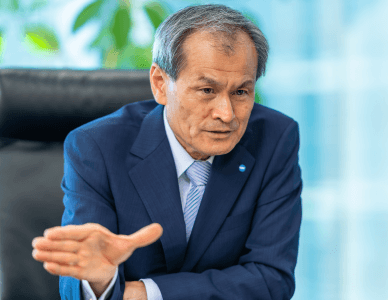
Evaluations of Konica Minolta by Outside Directors and Challenges
Three years have passed since you (Mr. Tomono) were elected Outside Director. How do you appraise Konica Minolta's corporate governance?
- Tomono:
- I feel like Konica Minolta is carrying out very progressive measures stoically while regulating itself rather strictly. In 2003, it transitioned to a company with committees (currently, a company with three committees) and in 2004 it began evaluating the board's effectiveness. Therefore, Konica Minolta made efforts to establish a strong governance system more than a decade before Japan's Corporate Governance Code took effect (June 2015). In recent years, too, under the leadership of Chairman Matsuzaki, the company has worked diligently to further enhance board effectiveness. The fact Konica Minolta has created its own better approach to governance from scratch instead of mimicking others enables various improvements and updates. Some feel that the corporate governance of Japanese companies is mere formalization lacking substance, embodied by the phrase "has the form but not the spirit." However, in the case of Konica Minolta, it created the form from an early stage, and later embedded the spirit after repeated actions (high effectiveness) to create its own form of governance today.
Did you notice any concerns or areas in need of improvement during your visits to the frontlines of various businesses?
- Tomono:
- A company is formed by many different "frontlines of work." In addition to the production floor, the frontlines include everywhere else such as accounting or human resources departments. The frontline that requires the greatest transformation in the future is likely the production floor. After visiting the production floor myself and talking with the engineers I found that the group has a real serious commitment to manufacturing. Built-up technical prowess and know-how developed through manufacturing are important assets. However, Konica Minolta is in the process of transforming and evolving its business portfolio. As such, I feel we need to reset our approaches to organizations and work. For example, I think we need to review from scratch collaboration between development and the production floor to transform development and production processes.
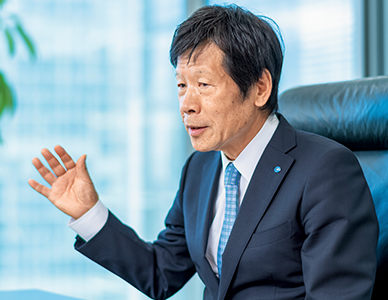
Progress of the SHINKA 2019 Medium Term Business Plan
The first year of the SHINKA 2019 Medium Term Business Plan is over. How do you assess the progress?
- Tomono:
- Overall, I think we are moving in a good direction. Under SHINKA 2019, we are working to boost profitability in our core business and accelerate new business creation that will support future growth, while utilizing the results of TRANFORM 2016, the previous Medium Term Business Plan where we prepared core technologies and strengthened our customer base. I feel like we are moving in the right direction. I would like everyone to feel comfortable in living up to their greatest potential and tackling new challenges with all their might. This requires careful monitoring of the progress of each measure and understanding the situation not through words, but rather numbers. Consequently, there is no need to have a negative outlook even if the numbers don't materialize as planned. Within Konica Minolta there is a wealth of knowledge and experience in business. This means we have many tools at our disposal to solve just about anything once we know the problem. The important thing is to implement a cycle where problems are quickly discovered and resolved without overlooking or ignoring them.
How will the Board of Directors aid in the achievement of SHINKA 2019?
- Matsuzaki:
- As with Mr. Tomono's assessment, I find the direction of the strategy appropriate. The major challenge now will be how to go about implementing this plan. When drawing up the plan for fiscal 2018 under the Medium Term Business Plan, I asked the business execution side to come up with the measures and numerical targets for this fiscal year along with the reason and basis for each. The Board of Directors will make this into a check sheet to monitor the progress of measures. To achieve the business plan, we, of course, need to continue to take on various risks. This is why I believe the Board of Directors must provide greater support to risk management. For example, recently we have made large-scale initial investments in bio-healthcare, and I have asked the officer of the Bio-Healthcare Business to think very carefully about any problems that may have been missed in carrying out this business. Going forward, the Board of Directors will aid the achievement of the Medium Term Business Plan from various angles, in an effort to achieve sustainable growth as a company and enhance corporate value over the medium to long term.


